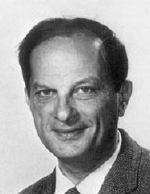
Born: April 3, 1909, Lwow, Austria-Hungarian partition of Poland (now Lviv, Ukraine)
Died: May 13, 1984, Santa Fe, New Mexico, USA
Early days.Stanislaw Ulam was born to a prosperous Polish-Jewish family in Lwow (Austrian occupied partition of Poland called then Lemberg; presently Lviv in Ukraine). His father, Jozef Ulam, was a lawyer, and mother, Anna Auerbach, the daughter of an industrialist. At the age of ten, Ulam entered the gymnasium in Lwow and, about this time, he became interested first in astronomy and then in physics. An uncle gave Ulam a telescope when he was about 12 years old and later Ulam tried to understand Einstein's special theory of relativity. However this required an understanding of mathematics and so, at age 14, he began to study from books, going well beyond the school level mathematics he was learning. He learned calculus at 16, and taught himself set theory from Sierpinski's book. Ulam said .... “We had a good professor in high school, Zawirski, who was a lecturer in logic at the university. I talked to him about it then and when I entered the Polytechnic Institute.”
Higher education. Now with interests in astronomy, physics and mathematics, Ulam entered the Polytechnic Institute in Lwow. In 1927, his first year at the university, he was taught by Kuratowski who had just been appointed to Lwow. Ulam obtained his Ph.D. from the Polytechnic Institute in Lwow in 1933 where he studied under Stefan Banach, a great Polish mathematician, one of the moving spirits of the Lwów School of Mathematics. He investigated a problem which originated with Lebesgue in 1902 to find a measure on [0,1] with certain properties. Banach in 1929 had solved a related measure problem. Ulam, in 1930, strengthened Banach's result.
Teaching and Research. In 1935 Ulam received an invitation from von Neumann to visit the Institute for Advanced Study in Princeton for a few months. Planning to spend three months there he sailed from France to New York. At the Institute for Advanced Study he met Birkhoff who invited him to Harvard University. Ulam said …”I became a lecturer at Harvard in 1940, but every year during that time [that is between 1935 and 1939 RS] I commuted between Poland and the United States. In the summers I visited my family and friends and mathematicians. In Poland mathematical life was very intense, the mathematicians saw each other often in cafes such as the Scottish Cafe and the Roma Cafe. We sat there for hours and did mathematics. During the summers I did this again. ...“ He, along with his younger brother fled Poland in 1939. The rest of Ulam's family was killed in the Holocaust.
In 1940 Ulam was appointed as an assistant professor at the University of Wisconsin. In 1943 he became an American citizen. Also that year, von Neumann asked him to work on the hydrogen bomb at the Los Alamos National Laboratory in New Mexico. Ulam—in collaboration with C. J. Everett, who did the detailed calculations—showed Edward Teller's early model of the hydrogen bomb to be inadequate. He was the first one to realize that one could put all of the H-bomb's components inside one casing, put a fission bomb at one end and thermonuclear material at the other, and use shock waves from the fission bomb to compress and detonate fusion fuel.
Ulam, with J C Everett, also proposed the 'Orion' plan for nuclear propulsion of space vehicles. While Ulam was at Los Alamos, he developed the 'Monte-Carlo method' which searched for solutions to mathematical problems using a statistical sampling method with random numbers. It greatly aided in solving many of the complex problems in creating an atomic bomb. It is now widely used in computer implementations of mathematical software.
He remained at Los Alamos until 1965 when he was appointed to the chair of mathematics at the University of Colorado. As he remained a consultant at Los Alamos, he divided his time between Boulder, Colorado, USA and Santa Fe, New Mexico, from which he commuted to Los Alamos. Later he and his wife spent winters in Gainesville, Florida, where he had a position with the University of Florida.
He was described by his friend Rota in the following way:
Ulam's mind is a repository of thousands of stories, tales, jokes, epigrams, remarks, puzzles, tounge-twisters, footnotes, conclusions, slogans, formulas, diagrams, quotations, limericks, summaries, quips, epitaphs, and headlines. In the course of a normal conversation he simply pulls out of his mind the fifty-odd relevant items, and presents them in linear succession. A second-order memory prevents him from repeating himself too often before the same public.
Honors and awards. Ulam's memberships in professional and learned societies included the National Academy of Sciences, the American Academy of Arts and Sciences, the American Philosophical Society, the American Physical Society, the American Mathematical Society, the Mathematical Association of America, the Polish Mathematical Society, and the American Association for the Advancement of Science. He was also asked to serve on the board of governors for the Weizmann Institute of Science in Rehovot, Israel, and the Jurzykowski Foundation in New York. Ulam was honored with such awards as the Sierpinski Medal, the Polish Millennium Prize, and the Polish American Congress Heritage Award, and was named the John von Neumann Lecturer of the Society of Applied and Industrial Mathematics. In recognition of his mathematical and scientific achievements, Ulam was awarded honorary degrees by the University of New Mexico (1965), the University of Pittsburgh (1978), and the University of Wisconsin (1978).
Source: a slightly modified article by: J J O'Connor and E F Robertson
St.Andrews university
GAP is Copyright (C) 1986--1997 by Lehrstuhl D f\"ur Mathematik,
RWTH Aachen, Aachen. Germany and Copyright (C) 1997-2001 by School of Mathematical and Computational Sciences, University of St. Andrews, St. Andrews, UK
GAP can be copied and distributed freely for any non-commercial
purpose.
Other sources:
Atomic Archives
Stetson University
Stanislaw M.Ulam papers
Encyclopedia Britannica
Return to home page:
Prominent Poles